If you’re like me, you are in the thick of canning season.
Over the past three weeks or so I’ve gotten something like 240 pounds of tomatoes turned into sauce, chopped tomatoes, salsa, various relishes, savory jams, etc. So it’s fair to say I’ve peeled many, many tomatoes. At this point, I think I’ve honed the process down to the fastest, most efficient way to peel tomatoes for processing, but if you know of any tips or tricks I’m missing, please share in the comments!
Just in case any regular readers aren’t familiar with the standard tomato-peeling process, it goes something like this:
- Cut small X in the bottom end of each tomato.
- Bring a pot of water up to a boil.
- Blanch a few tomatoes at a time in the boiling water.
- Transfer blanched tomatoes to ice water bath to stop the cooking and to cool the tomatoes so you can handle them.
- Use a paring knife to peel away the loosened tomato skin, then core the tomatoes and process as directed by recipe (chop, halve, crush, etc.)
I have concluded that this is a stupid way of blanching and peeling tomatoes for canning if you are working with a lot of tomatoes. It forces you to handle each tomato about a dozen times, necessitates coring tomatoes that are already peeled (a slippery job), utilizes all the ice in your ice maker and is generally inefficient. When I’m canning 100 pounds of tomatoes at a time, inefficient is the enemy.
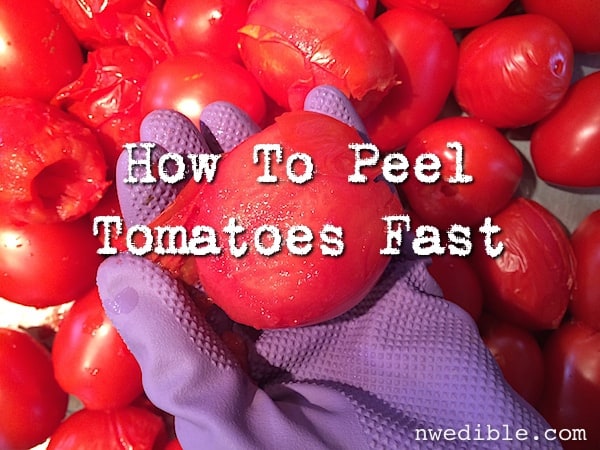
A Better Way
Fast tomato processing requires the right tools and the right set-up. I’m going to go through the steps to most efficiently process tomatoes through the peeling stage in rather redonkulous detail. So much detail, in fact, that you will think “how could doing all this save time when it takes me five minutes just to read this stupid blog post?” I just ask that you trust me – this set up is faster to implement than it is to explain.
You Will Need:
A big-ass pot of water on the highest heat your stove can muster. Bigger is better. If you don’t have a big pot, go borrow one from a neighbor. The more water is in your pot, the higher temperature it will hold when tomatoes are added and the faster you can cycle batches of tomatoes through the boiling water.
A big-ass skimmer, slotted spoon, or shallow sieve. Whatever you have that will allow you to remove the tomatoes from the water in as few dips as possible. This is not the time to hunt around for each individual tomato. Think batches! I use a big, inexpensive Chinese-style deep-fry skimmer (like this). This is an extremely versatile tool and highly recommended.
A big-ass sheetpan or several (are you noticing a theme?) upon which to set your blanched tomatoes.
New, inexpensive rubber dish-washing gloves. They should not be big-ass gloves unless you happen to have big-ass hands. A comfortable but not overly large fit is best. The gloves should be new so you can dedicate a pair specifically to peeling tomatoes and other food-prep tasks.
Don’t use rubber gloves that have been used to scour moldy fish remains off a casserole dish (gross) or have spent time inside the bacteriological soup that is your typical wash tub (also gross). Spring for the extra $2 at the grocery store for a new pair, and make sure they have grippy, textured fingers. That will be important later on. When not in use, dry these gloves well and keep them with your other canning gear.
Set Up Two Stations
You will need two stations – a Wash/Core Station and a Blanch/Peel Station. These details seem fiddly but trust me – setting up your work station the right way will save you a ton of time over the course of 100 pounds of tomatoes.
Your Wash/Core Station should be at your sink. As always, start by sorting through your tomatoes to get rid of any tomatoes with mold, soft spots or decay. For canning, tomatoes that are just ripe but slightly firmer than you’d prefer for fresh eating are good. The fastest way to wash tomatoes is to clean and sanitize your sink. Fill it with cool water and add a few drops of soap and several big glugs of white vinegar. Dump all your perfect tomatoes in the water and give it a swirl. No need to rinse – the blanching process itself will rinse the tomatoes of any residue.
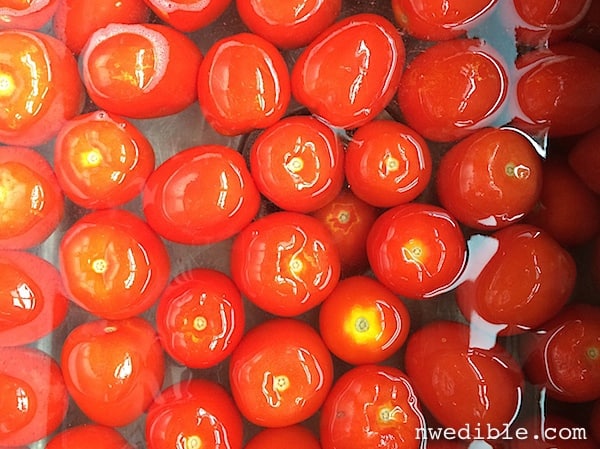
Adjacent to your sink, set a medium colander and a medium bowl. If you are right handed, set these items to the right of your sink, with the colander just behind the bowl. Set a small paring knife next to the bowl.
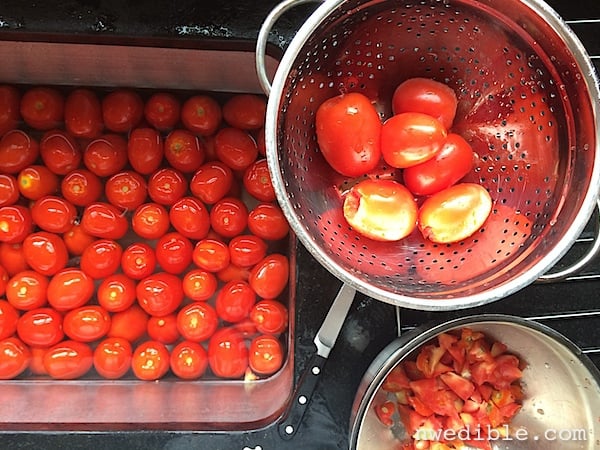
Your Blanch/Peel Station will be at your stove. Set that big-ass pot on your strongest burner (lid on) and bring it up to a boil. Set a sheetpan next to the pot. If you are right handed, it will probably make the most sense to put the sheetpan to the right of the pot, but the logistics of your stove and countertop may prevent this. Set the big-ass skimmer on the sheetpan and have those gloves handy.
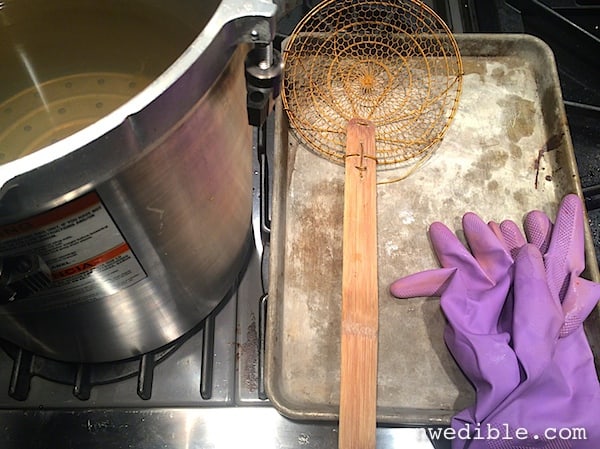
Step by Step
All these instructions assume you are right handed. If you are left handed, flip everything around so it’s comfortable and efficient for you.
Stand at your Wash/Core station, comfortably in front of the colander and bowl. Hold your paring knife in your right hand, just over the bowl. Reach your left hand down into the sink, grab a tomato and bring it to your paring knife. Use the knife to twist out the tomato core. Move your left hand, still holding the tomato, back slightly and drop it in the colander.
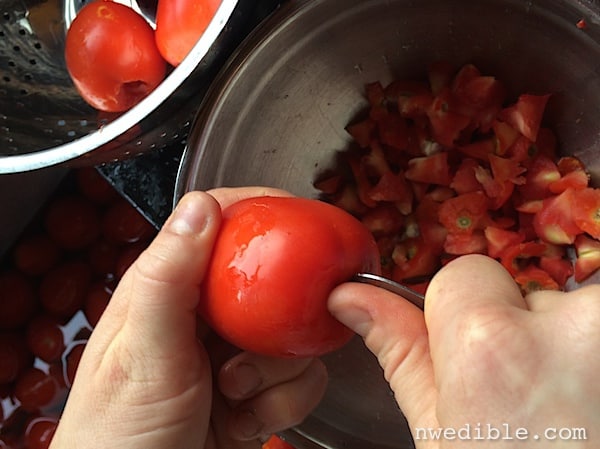
Repeat this step of grabbing a tomato with your left hand and bringing the tomato to the knife in your right hand to core as many times as it takes to fill up your colander. If you are doing this right, at no point should you switch hands or move the tomato any more than absolutely necessary. You should also not have to move or take any steps back and forth to grab or prep the tomatoes. If you have to move much while doing this, finesse your setup until you can complete your task with the minimum amount of motion.
You want to fill the colander with as many tomatoes as you can core in about a minute. This should be between 10-20, depending on how fast you are. Put on awesome music or pretend it’s a race – whatever gets you moving.
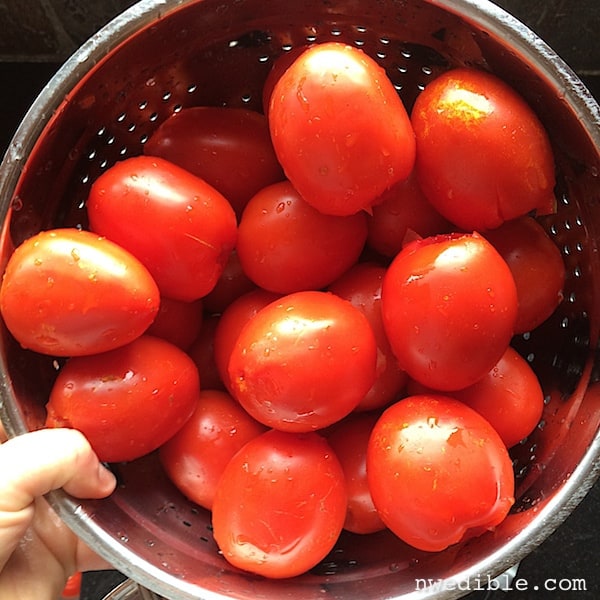
When the colander has your “one minute of tomatoes” in it, set down your knife and take the colander to the pot of boiling water. Dump the cored tomatoes into the pot of boiling water and return to your Wash/Core Station.
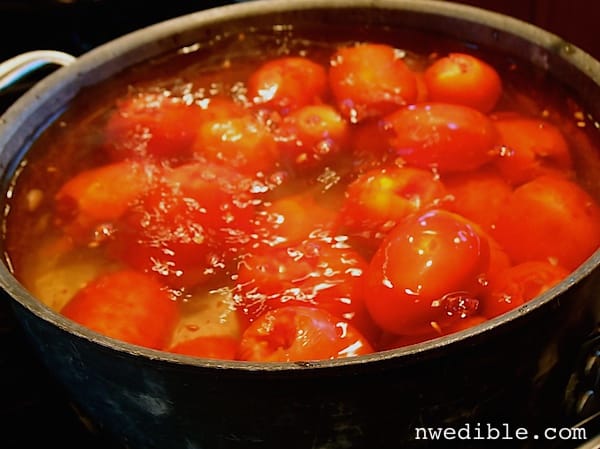
Continue coring tomatoes as before for one more minute, give or take, as your first batch of tomatoes blanches. The idea here is that, as one batch of tomatoes blanches, you are preparing the next batch for the blanching water with a minimum of wasted time and effort.
When Batch One is finished blanching, after about a minute, take Batch Two with you in the colander to the Blanch/Peel Station. Use your big-ass skimmer to scoop out the Batch One tomatoes, shake off the extra water, and set them on your sheetpan in a single layer. Do not be tempted to mound the tomatoes up – they need to be in a single layer to cool effectively.
Give your pot of water a second to return to a boil while you have a sip of water (hydrate!), then drop Batch Two into the boiling water. Repeat this process as many times as necessary until you have filled up your available sheet pans and/or blanched all your tomatoes.
Now Peel
Put on those dedicated rubber gloves. Some of your tomatoes are going to be hot, but that’s not a problem when you are wearing thick rubber gloves. That rubber sheath will kill much of your sensitivity for such things. At least, that’s what my guy friends in college were always saying.
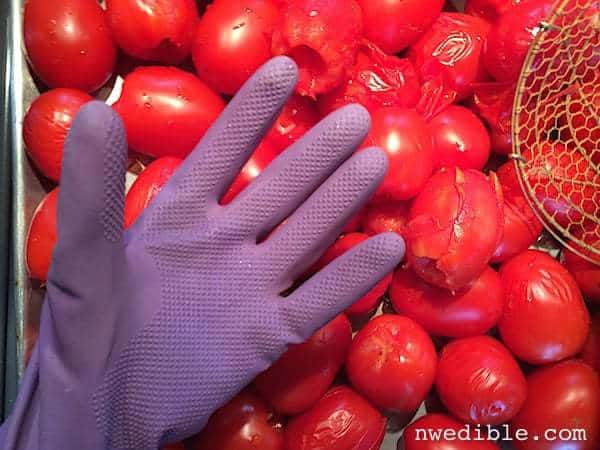
With the grippy rubber gloves on, just pick up the tomatoes and slip them right out of their skins. Put the tomatoes aside for whatever process you’ll be giving them and drop the skins back on the sheetpan – you’ll want them to combine with the cores later for Nearly Free Tomato Sauce.

Here’s a video that shows how the rubber glove-peeling works. Here I peel 7 tomatoes in 21 seconds, so I can comfortably peel one tomato every 3 seconds, or about 20 tomatoes a minute.
What I Skip And Why
I skip cutting the X in the tomato because, with the core removed, the tomato skin is already “broken” and it saves a bunch of time to only do the coring step which is necessary for further processing anyway.
I skip the ice bath step, because dropping tomatoes in water makes them….watery! Much of the tradition of blanching tomatoes comes from a haute cuisine technique of serving raw, peeled, seeded, diced tomatoes (tomato concasse) in salads, as a garnish, or in lightly cooked preparations like quick, fast pasta sauces. My method of using tomatoes is decidedly more casual, and since these tomatoes are going to be further processed into sauce, crushed tomatoes, ketchup, etc., I really don’t care if they continue to cook for another few minutes on the sheetpan after blanching. They’ll be fully cooked anyway before they go in a jar.
There is a case to be made for ice-water-bath shocking tomates you will raw pack whole, however, having done it both ways, I can’t say I notice much difference in the texture of ice-water bath shocked tomatoes and sheet-pan cooled tomatoes. Raw, whole tomatoes are processed in the boiling water bath canner for 85 minutes, after all.
I skip peeling the tomatoes with the paring knife which – while fast – is not as fast as peeling with grippy rubber gloves. Fast is the name of the game when it comes to making the bounty of summer a little more manageable.
What are your tricks for processing big quantities?
88
Here it is Sept 3rd and it’s going to be 95° F and the humidity is approaching 90%. I don’t have AC, so the last thing I want to do is boil a big ass pot of water on the stove. Also, I started picking tomatoes in July. So every time I pick tomatoes I pop them into a plastic bag and put them in the freezer. I’ll can the lot when the temps come down. And you know what? Once they thaw, skin just slips right off ‘em. Much easier.
This is the way my mom does it. Works great if you have the freezer space. A full freezer is more efficient than an empty one anyway.
I agree. If I’m processing them right away, I don’t peel and just use the immersion blender. If I can’t get to them, they go in the freezer and after they thaw, the skins pop right off. I’ve got other things to be processing, so I get to the frozen tomatoes when I can (usually in November).
I don’t peel or seed them. I just cut them into large pieces and puree in the food processor, then boil it down to desired thickness for sauce. Tastes fine. We don’t use whole peeled tomatoes in our house.
I don’t peel them either. Its not like the skins aren’t perfectly edible, and as long as you’ve washed them there’s nothing on the skin to worry about. And you’re going to use the skins ANYWAY if you’re thrifty…..so why peel? At least for sauce and other pureed items it doesn’t make sense to me.
This is kind of like the way I do it most of the time but I use the sauce attachment on the Kitchen Aid. I know it means I miss out on having whole tomato chunks but I really don’t care and watching the sauce attachment on the food processor whir and spit out tomato sausage ‘poops’ is so much more fun anyway.
I’m with you on that Laurel – it was my first thought when I saw this article. So many articles this time of year about peeling tomatoes! Even oven roasted tomato recipes call for peeling. I made some last night with the peels ON and they were just as delicious and no one in my family minds the texture. (Put a layer of sliced tomatoes in the oven at 450 degrees for 30 minutes and YUMM. Only after they have roasted do you add spices and other veggies otherwise they just don’t come out the same.) Plus I’m sure the peels add fiber and vitamins so I hate to waste them. I usually can them sort of “diced” with the peels on too but I also try to avoid canning as much as possible. But everybody has their way, and I sure do appreciate all the info you share, Erica.
I like the peels too. I also like apple peels in applesauce and skins on potatoes when they’re mashed etc. I guess it’s how I grew up with my depression-era dad doing most of the cooking.
Both these ladies make good points, but 1) I just don’t have that much freezer space to spare at this time of year; and 2) we do use canned tomatoes although I’m with her when it comes to making sauce 🙂
But I had a old country-woman for a neighbor years ago and her method of peeling beats all for speed. To be honest, I thought it was pretty gross at the time but I was less into efficiency back then and she canned a heck of a lot more tomatoes than I did.
Here it is: take a huge big-ass vessel of just about any description and fill it most of the way full with the tomatoes you want to can. She used a 5-gallon plastic bucket. Heat a big vat of water to a full boil and pour it over the tomatoes in the bucket. Go away until they are lukewarm. Come back and take one tomato at a time in your hand over a receptacle for your tomatoes. Holding the tomato at the stem end, give that now-mushy tomato a good squeeze and all the tomato guts will come out. Now simmer into sauce or put them in jars and can. Use multiple buckets if you are doing a huge amount at one time. And obviously you could take those skins/cores and process them further into whatever you wanted.
She used to do this while sitting on her screened porch, buckets on the floor in front of her chair. Frankly, it hardly seems like work if you do it this way although you did have to sit up and lean over the buckets.
I love your old country-woman method! I’m totally trying it next year (in a big stainless steel pot, I think, not a bucket). Will report back! I agree with the freeze-blanching of tomatoes. I love it in theory but I just have too many tomatoes (or too few freezers) to make that system work.
Your neighbor was a genius.
Yes, she was!
I don’t core or cut an x before blanching. I just toss a bunch in the boiling water and once they start puffing a bit, give one or two a good whack with the edge of a butter knife or other utensil. If the skin splits, they are ready and out they come. Note: I only use ripe tomatoes so don’t find core is an issue. Have used a dedicated tomato crusher which handily takes of the peels and seeds while making the passata. This year, I don’t have access to one and will be trying a moulis so I will have to see how that goes. But slipping the skins off at this point is super easy and can be done while dropping the tomato into the mill, which I think will help it from getting to gummed up.
I use my strawberry huller to core tomatoes. If I am using them fresh (say in a BLT), this is easy peasy. Probably will use for canning, too…..
You are a goddess of organisation! And this is one chore I skip in favour of store bought fast an cheap. We enjoy garden tomatoes 2 to 3 months of the year and then it is back to the store. The advantage of age. Our hormones are beyond messing with and if something causes cancer in 30 years who cares.
“Our hormones are beyond messing with and if something causes cancer in 30 years who cares.” I love you Ien.
Hey, Ian, you stole my line! It really horrifies the young, but older folks just nod knowingly. It is very freeing to know you are on the downhill side of the mountain!
Would this process work for freezing as well? I have tried to can tomatoes…..ugh, without success. I now freeze them and that works well for me. Thanks. L
Erica, your method is lovely – so organized, efficient, and controlled! I’m impressed. I love how you figured out bowl- to- collander placement.
But I think your method has been trumped in quick succession by a countrywoman’s 5-gallon buckets on a porch, by others’ indifference to peels, and finally by the easy lure of “the store.” What to do?
Get ready for some bigass gloating (not that it’s ever your style, but today I give you this gift, ok? )
Here comes your chance:
You canned 240 pounds of red ripe tomatoes!
My tomatoes are still green.
Yup. Here in the south hills of Eugene, there’s a bunch of us standing shoulder to shoulder with our deer (picture them with assorted leaves in their mouths) (the deer, not the gardeners) and we’re all just shaking our heads. Green! Still!
So I’m going to stare at your pictures of red tomatoes and live vicariously today.
And then I’m going to go to the store. Thank goddess I’m post- hormone-messing age; I think I’ll by two cans of sauce.
I’m standing with you, Sanj, a few miles southwest. And to add insult to injury, the deer got into my garden earlier this year and did a righteous prune on my tomatoes, not to mention the raspberries. Bah! I have had a few ripe tomatoes, but the canning-quantities are mocking me with their stubborn green.
Awesome! I’m a wimp when it comes to handling hot things(and too impatient to wait for ice bath to fully work) and hated the peeling step. I wonder if this would’ve saved me some trouble with the peaches this summer?
Oh and those purple gloves are what I use for working with my beehive! Mine are covered in propolis residue so no chance of mixing those up with new clean ones. 🙂
Thank you for this info, Erica. Very helpful! I have a 32 gallon tote full of Golden Rave tomatoes on my kitchen floor, a large pot full of them ready to peel, and more on the plants. They are smaller, oblong and the cores are not much of a problem, so I cut both ends off and am ready to process…though now it seems I could just cut the core end off and be ready to go. I’ll pick up some gloves today after work and see if I can get them done in record time!
I love this! I’ve been looking at a couple hundred pounds of tomatoes ripening and dreading the peeling of all of them. I will definitely be using your method!
THANKS
I wash them, core them, cut them in half and put them cut side down on a jelly roll pan. Pop in the broiler until the skins blister. Remove, let cool. Pour the tomato juice off and save for fresh bloody mary’s. Pinch the skins off with your fingers and save for free sauce or tomato powder, but that’s another show.
The tomatoes are now peeled and you have lost a lot of the extra liquid you don’t want.
Something else you can do with the cores and skins is dehydrate them, then crush into powder. when you need a little tomato paste, just take a spoonful. You can hydrate it back up with a little water, but most recipes you can just stir it right in for a little tomato punch. Super easy, and stores great
LOVE it, thanks!
Well, you’re making me feel like a slacker. I’ve had a big bag of tomato “seconds” from the farmer’s market in my fridge, and the last few of my homegrown tomatoes on my counter, which I’ve been meaning to can since Saturday and just haven’t gotten around to yet. So, I guess tonight’s the night. Thanks for giving me the motivation!
I’ve tried cutting them in half, placing on a greased sheet pan (cut side down) and roasting them for 20 minutes or so. Then the skins come off easily and I dice them up, simmer them for a short time, then can them. It’s also pretty quick and hands-off, and gives the tomatoes a yummy flavor from the roasting. But I can in much, much smaller batches than you do.
I’ve never bothered with the “X” since my tomatoes always split by the time they come out of the water. The best gloves I have used for canning are the silicon-dipped ones sold for gardening. I have two pairs marked with a big K for Kitchen. When I’ve used dish gloves on hot canning jars the rubber gives way after a few uses. The silicon gloves fit really snug and so far have lasted a few seasons.
The fastest way I do tomatoes is with a blender. Either fresh or frozen/thawed, I just dump them in whole and blend them before cooking down. I’ve never thought twice about the skins or the cores (but I like the tomato powder idea above for when I need a bit of paste) as long as it’s a high speed blender (the stick blender seems to leave little skin bits which some people don’t like). The boiling hot water is the worst part of any canning project for me, so the less I need to use it the better. With an extra frig/freezer in the garage I freeze a lot of tomato and spaghetti sauces and am due to do more. I ‘ll try the roasted method next. Thanks for all the great ideas!
With the kids grown and out of the house, there is just the two of us, so canning some things (including toms) just isn’t worth the effort. For the most part, I roast my tomatoes for sauce, with garlic, olive oil, a little salt, and basil. Makes amazing sauce – and if I have a bulk amount, I’ll freeze the extra. Having said all that…I love your method and organization!
I have complete sympathy! Circa 1983 I was working in Switzerland and we used to buy Italian plum tomatoes by the crate load and prepare them for the winter season – core, blanch, peel, squeeze, toss in hot olive oil with basil, vacuum pack, freeze. There is a photo of us doing this on my blog (which I’m not trying to get you to read! – just think you might like the photo. I’m middle left). http://tasteandlight.com/2013/12/11/bread-soup-hotel-kulm/
Very cool! Thanks for sharing! I enjoyed the photos despite their ‘yesterday’ quality.
Here’s my question, and I haven’t been able to find the answer ANYWHERE. I call the cooperative extension in my state, I’ve looked in every canning cookbook I have, and done tons of google searches. Here it is: Is there any botulism/safety related reason to peel the tomatoes for canning or is it purely texture/asthetic? The truth is, I always can with the peel on but I’ve always been a bit concerned that there is some safety reason that I am overlooking. Thanks!
AFAIK it’s a texture thing. Slivers of peel can get caught between your teeth and feel just horrible. I think Erica called it “a floss job from Satan’s dentist” or something to that effect.
Hah! You’re right – I did. I know many people don’t mind the peels, but I don’t care for them in long-cooked tomatoes, typically.
There is no botulism/safety reason to peel the tomatoes for canning. In water bath canning, botulism is prevented by stopping c. botulinum spore germination from ever happening. This is achieved through sufficient acidulation. Other potential pathogens, molds, etc. are prevented through sufficient processing time. Removing the peels is purely because many people find them unpleasant in texture. However tomatoes must be clean, wholesome and without rot, mold, or squishy bits before processing. Field grown tomatoes are occasionally dirty or have leaf bits kind of rotting on them. Make sure sort and clean your tomatoes very well before processing to remove contaminant load.
Erica, thank you! I figured there was no reason other than texture, but it still freaked me out a wee bit. And since I leave peels on I am always extra cautious about cutting out any and all bad parts of the tomatoes and excessively cleaning them. I really appreciate your response. We personally don’t even notice the peels, so I will just continue to save the time.
OK this explanation helps me too. I was trying to figure out why you had the washing station! I always sort my tomatoes and take out any icky ones, but then figure I’m putting them in boiling water, so…ummm…isn’t anything going to be killed in there? But I’m canning my own homegrown toms, so I take it that this is a farm-purchased issue…
My method has been to x, blanch, into a bowl of cold water beside the boiling pot; when cool enough to handle, gently squeeze off the peels, and then dump into a food processor. When the processor is full, whizz to chunky puree and dump into large pot to simmer. I do have to change the cold water periodically, but I don’t have to run back and forth to my sink. Given that I skip the washing, I don’t feel like I’m over-handling them. But I may give the gloves a try–you make a convincing case! 🙂
Genuis idea, love it!
Thanks!
As it happens, I do have big-ass hands. 🙂
I use my canning-bath pot to do this kind of thing.
I’ve done the “core instead of cutting an X” thing and… maybe it’s because I wasn’t using roma (or other meaty, not-so-seedy) tomatoes at the time, but I got some VERY water-logged tomatoes as a result.
Thoughts?
Love the use of clean, nubbly rubber gloves to get the skins off, though! 😀
Similar to country neighbor technique and Erica’s (everything and everyone has a specific job and place outlined in advance). Also there are at least 2 of us doing the canning so obvious advantage there…
We use a big (16 gal) pot, aka brew kettle with a giant steamer basket that fits inside. Using a propane burner (outside) we heat the water in the big pot and load the basket with tomatoes (holds ~20 lbs). Once the big pot boils we lift the basket out, drain for a min or two, and dump the tomatoes into a 40lb meat tote. Then while one person fills the strainer basket again the other will be scooping tomatoes into the food mill attachment for our meat grinder and reprocess until pretty dry (removes skin, cores, and most seeds). The tomatoes are ground into our 10 gal pot (mash ton) which we heat on our camping stove to reduce.
It took us 3 hours to process 160lbs into sauce this year.
Yes the Cabelas fruit strainer attachment for their meat grinders blows the kitchenaid attachement out of the water.
Impressive. This morning I tried something new. As suggested by another commenter, I roasted 12 pounds of halved tomatoes in the oven, poured off the juice, blended the tomatoes at high speed and am researching spices to add to the resulting divine, perfect tomato sauce. Tomato work: 1 hour, Internet “research” 2 hours. You definitely did better with your 3 hours! However, I have impressed myself with the roasted flavor and non-watery texture I’m looking at in my pot right now.
We are pretty similar in how we do things. I didn’t think to use dish soap in my water I like that. I like to use a strawberry corer to scope out the button of the tomatoe. I even have that “Big A” wok skimmer thing.
Thank you, I enjoy your articles.
Tanaya
Hi Erica, I’ve just recently found your blog and while I’ve enjoyed what I’ve read so far, this post has made me a huge fan. Really great info (seriously, why didn’t I think to use grippy (purple!) rubber gloves for this?) – but it was a single sentence you wrote that won me over >> “They should not be big-ass gloves unless you happen to have big-ass hands. ” I’m still laughing….. 🙂
Yes! I love efficiency comparisons. You’re the best!
I don’t peel except for making jam and salsa. Then I just core and dip and slip the peels. For the majority I make quarts of juice, not as thin as drinking juice you buy in store, but not as thick as a tomato sauce. I use this for base of curries, pasta sauces and pizza sauce, soups, chili, rice dishes. I don’t make catsup as the couple containers we use per year would be a waste of time. I prefer concentrated tomato paste in a tube for the times I need that, a T or 2 at a time. I used to drop in ice bath years ago as was taught that way, but I got lazy. Just let them cool off and works fine. I should try the gloves though and skip the paring knife.
(smacks forehead)
It never occurred to me that the icing is pointless. What a decrease in time and mess. I’ve put up three boxes and just bought two more. Definitely giving this a go, skipping the icing step.
I will say that I have gotten pretty darn handy coring the tomatoes with my right hand and then squeezing them out of the skin with my left hand. Coring them before putting them in the boiling water always seemed to make a bigger mess. Is there a compelling reason to core them first?
Nice comments, everyone, but why am I the first to note: “At least, that’s what my guy friends in college were always saying.” Erica, you kill me!
Not the first to notice, but you’re the first to say anything about it 🙂
My wife always says I am not as organized in the kitchen as I should be. You just proved her wrong I have been doing almost the same technique for the last two years although your changes to the system are the key to cutting down the time significantly. I will ommit the ice water and the x on the tomatoes and then I think I can increase the number of tomatoes I do at a time, I have been doing this method largely but with maybe half the tomatoes. I bet this will save me another hour or more when I can tomatoes this year. Thank you.
Erica! Wow. I have processed hundreds of tomatoes this summer; wish I knew then what I know now!! Thank you so much. I’m sharing this with my readers. Happy summer.
I adjusted a couple things this evening, namely using a big strainer (glory hallelujah!!!!!!) and skipping the ice bath. Holy moly did that ever dramatically cut down on prep time. This needs to go in the book!
I usually peel and seed with the old fashioned “x” and blanching/shocking method. Next year I may try the rubber glove method. I had 6 plants and probably got over 100 lbs this summer, most of it eaten fresh, or turned into sauce and frozen (I don’t can).
This year, because for the first time ever, I got a TON of romas off one plant, I did something a bit different. There were too many to core and peel, so I just cut off the ends, cut them in half and threw them in a pot. I cooked them until they were soft and then ran them through a Squeezo I borrowed from my mom (which probably belonged to my Grandma at one time). I was really impressed with how fast it was and it gave me the most perfect sauce/puree with no skin and no seeds.
I just googled “squeezo” and this tool is not cheap, but if you can borrow one, I highly recommend it.
I do mine in the oven. In a deep sided baking dish I layer tomatoes that I have halved and cored. Pile em up to level with the top of the dish… Mine is about three inches deep. Then I put them in the oven to heat thru (while I am working on something else… Dinner?), the juices run and fill the pan and the skins loosen. At that point I bring it out of the oven… Slip off the skins (I am loving the rubber glove idea… I am doing that next time) and return them to the baking dish. Once all the skins are removed all you have left is hot tomatoes in their own juices ready to throw in jars and can. This gives me one canner full. Although I am usually doing smaller batches I think this could work for larger batches too.
Love this! I am definitely going to try a batch this way.
Just did a box of peaches over my lunch hour this way! Thanks!
Best trick I was taught about canning. Don’t can indoors! Revolutionary. Get one of those big propane burners (they can be called turkey fryer or lobster cooker depending on where you live). It hooks to a normal tank of propane and voila, my canning kettle sits on the deck boiling tomatoes for hours not in my hot kitchen!
OMG! When I try my hand at canning tomatoes, I know it will be with a smile every time as I think about how that rubber sheath kills much of the sensitivity. 🙂
Thank you for posting about this. My friend phoned me on Tuesday, she had hit her limit for being able to put up ANY more tomatoes. She brought over two big baskets of them and yesterday I set up my assembly line like you suggested. It took me 2 hours to end up with 32 cups of chopped peeled tomatoes. I also used your suggestion for using up the skins. I ended up with 6 cups of paste and a LOT of salsa! Thanks so much!! I used vomitingchicken.com’s salsa recipe – http://vomitingchicken.com/doin-salsa/
Erica, I tried your method today and love it! I was never very good at the ice bath method. So much water/ice was used and I made a huge hot mess in the kitchen. Today I’m amazed at how quickly things went, my kitchen was tidy throughout and I was done in record time. Awesome!
you kill me. I love your posts. I like that you speak freely and your jokes(guys in college)are great. Looking forward to canning next season and omitting the messy ice water bath. thank you for all the tips!!
I used this method for our marathon day of canning salsa (50 pints!) that we do every year.
The results were fantastic! Because I don’t want a lot of tomato water in my salsa not shocking the tomatoes in ice water really did cut down on the mess while cutting and cleaning.
This method is faster, easier, and so much more enjoyable.
The only alternation I made was not peeling while washing/boiling the tomatoes, instead I washed while one batch boiled and lined up all the sheet pans on one side of my kitchen counter then peeled all at once (savings those skins and cores like Erica suggests!)
Thank you Erica! I will never go back!
Love this post! I included your link in my round up post “ultimate guide to using excess tomatoes”
Thanks for the great info!